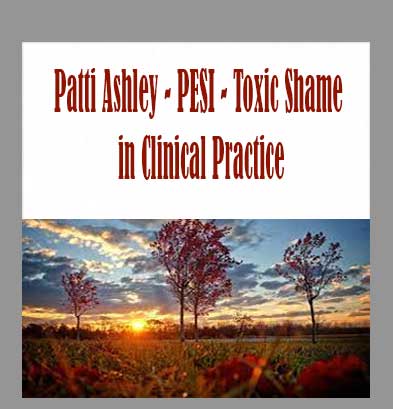Patti Ashley – PESI – Toxic Shame in Clinical Practice: Help Clients Release Shame, Get Unstuck and Improve Treatment Outcomes
Description
Patti Ashley – PESI – Toxic Shame in Clinical Practice: Help Clients Release Shame, Get Unstuck and Improve Treatment Outcomes download, Patti Ashley – PESI – Toxic Shame in Clinical Practice: Help Clients Release Shame, Get Unstuck and Improve Treatment Outcomes review, Patti Ashley – PESI – Toxic Shame in Clinical Practice: Help Clients Release Shame, Get Unstuck and Improve Treatment Outcomes free
Patti Ashley – PESI – Toxic Shame in Clinical Practice: Help Clients Release Shame, Get Unstuck and Improve Treatment Outcomes
Clinicians often report feeling “stuck” and unsure of the reasons why clinical strategies aren’t working. In this recording shame expert, Patti Ashley, Ph.D., LPC, will help enhance your clinical skills using neurobiological-informed and relational-informed strategies for identifying and treating toxic shame.
Toxic shame is like an infectious disease that lies untreated due to symptoms being difficult to recognize or misdiagnosed. Learning how to recognize and treat toxic shame requires you to be vulnerable and courageous in the therapy session.
Recognizing the signs of toxic shame in the assessment and treatment process can be difficult. Here are some examples of client behaviors to watch for that could indicate shame:
- Frequently cancels sessions
- Terminates treatment early
- Deflects and projects onto others
- Narcissistic self-inflation
- Perfectionism
- Minimization
- Anger, rage and contempt
- and more
This recording will take you back to the origins of shame and help you identify the non-verbal unspoken and unseen aspects in clinical work. Understanding how shame can undermine the therapeutic alliance and using somatic strategies to deepen an authentic relationship with the client are the keys to working with toxic shame in clinical practice.
Dr. Ashley has heard other clinicians who have taken this workshop say they experienced a “sigh of relief.” This is a recording you don’t want to miss!
Speaker
Patti Ashley, PhD, LPC, is a psychotherapist, international speaker and best-selling author of Shame-Informed Therapy: Treatment Strategies to Overcome Core Shame and Reconstruct the Authentic Self (PESI Publishing, 2020).
With over 20 years of experience as a licensed counselor, Dr. Ashley brings unique insights into the identification and treatment of trauma, shame, grief and dysfunctional family patterns. She has counseled individuals, couples, families and groups in mental health agencies, psychiatric hospitals, and practice settings. She currently maintains a practice in Colorado where her Authenticity Architecture model helps clients break through unconscious barriers and rediscover a sense of self-love, belong, and connection.
In addition to her book for psychotherapists, Dr. Ashley is the author of Living in the Shadow of the Too-Good Mother Archetype (Wyatt-MacKenzie Publishing, 2014) and Letters to Freedom (Wyatt-MacKenzie Publishing, 2019). In addition to her clinical work, Dr. Ashley develops and teaches continuing education courses for psychotherapists, physicians, hospital wellness programs, universities, and several organizations.
Speaker Disclosures:
Financial: Dr. Patti Ashley has an employment relationship with Authenticity Architects. She receives royalties as a published author. Dr. Ashley receives a speaking honorarium, recording, and book royalties from PESI, Inc. She has no relevant financial relationships with ineligible organizations.
Non-financial: Dr. Patti Ashley has no relevant non-financial relationships.
Objectives
- Summarize the nature of toxic shame as it relates to the therapeutic process.
- Identify how the different attachment styles play a role in how client’s shame is formed.
- Discover how toxic shame develops as a core identity and how it can be a roadblock in clinical treatment.
- Correlate how toxic shame and trauma function similarly to the nervous system and how that relates to clinical treatment.
- Utilize clinical strategies to help heal shame and get clients unstuck in the therapeutic process.
- Develop skills to help clients regulate shame triggers both in-session and everyday living.
Outline
PART ONE: HOW SHAME SHOWS UP IN TREATMENT
Toxic Shame
- Research & DefinitionsRuptures in interpersonal relationships create a shame-based identity
- Shame and trauma function similarly in the nervous system
- Subconscious shame effects of poisonous parenting
- Attachment theories as they relate to shame
- D.W. Winnicott’s true self/false self
- Shame in family, culture and other systems
- Limitations of the research
Signs of Toxic Shame:
What to Watch for in Assessment and Beyond
- Individual Therapy – the client who:
Talks the whole session
Frequently cancels sessions
Feels bad when progress seems to have eluded
Terminates treatment early
Deflects and projects onto others
Relapses and does not return
Minimizes problems
Excessively intellectualizes and analyzes treatment - Couples/Family Therapy
The attack/defend patter
Anger, rage and contempt
Judgment of self and others
Grandiosity, narcissism and self-inflation
People pleasing and codependency
Avoidance
Problems with intimacy - Group Therapy:
Cross-talk
Intellectualizing
Silence
Judgment
Conflict
When the Therapist is Part of the Problem
Rigid Treatment Models May Increase Shame and Decrease Positive Outcomes
- Shame can be activated when therapist appears to be the “expert”
- Some strategies hinder treatment outcomes
- Strategies that may create barriers to creativity and relational presence
- Impact of mirror neurons and epigenetics
- How naming “shame” can be shaming
- Unconsciously enacting shaming parent
- Treating client as appointment or diagnosis
- What to do when your shame is triggered in-session
PART TWO: TREATING THE TOXIC SHAME
Effectively Treat Toxic Shame
Implications for Treatment to Move Forward with Clients
Right and left brain integration
- Bottom-up versus top-down treatment approaches
- Modeling, engaging and sustaining self-compassion
- Repair the interpersonal bridge to self and others
- Courage and vulnerability in right-brain regulation
- Sustaining empathy in parallel process
- Transference and counter-transference in treatment
Therapeutic Strategies:
Putting It All to Practice
- Build a Safe Therapeutic Holding Environment
Establish safety and trust
Set a stage for treatment
Strong foundation for therapeutic work - Build a Solid Relationship
Therapeutic empathy as the antidote for shame
Connect and establish equal power
Mindfulness and compassion - Bridge the Head and Heart
Psycho-education to demystify shame
”I” statements to identify shame-based feelings
Going beyond cognitive therapy models - Witness and guide clients through deeper layers
Return shame to its origin
Somatic strategies
Re-wiring new neural pathways - Experiential Tools and Techniques
Creative arts, writing and movement activities
Mindfulness and meditation
Archetypes, story-telling and mythology
Music and sound healing
Journaling and letter-writing - Working with Secrets
Patience and compassion
Deeper shame
Tolerance and non-judgmental witnessing - Creativity
Every client is unique
How therapy is like art
Goodness of fit - Research limitations and potential treatment risks
Target Audience
- Counselors
- Social Workers
- Psychologists
- Case Managers
- Marriage & Family Therapists
- Other Mental Health Professionals
- Chaplains/Clergy
Frequently Asked Questions:
- Innovative Business Model:
- Embrace the reality of a genuine business! Our approach involves forming a group buy, where we collectively share the costs among members. Using these funds, we purchase sought-after courses from sale pages and make them accessible to individuals facing financial constraints. Despite potential reservations from the authors, our customers appreciate the affordability and accessibility we provide.
- The Legal Landscape: Yes and No:
- The legality of our operations falls into a gray area. While we lack explicit approval from the course authors for resale, there’s a technicality at play. When procuring the course, the author didn’t specify any restrictions on resale. This legal nuance presents both an opportunity for us and a boon for those seeking budget-friendly access.
- Quality Assurance: Unveiling the Real Deal:
- Delving into the heart of the matter – quality. Acquiring the course directly from the sale page ensures that all documents and materials are identical to those obtained through conventional means. However, our differentiator lies in going beyond personal study; we take an extra step by reselling. It’s important to note that we are not the official course providers, meaning certain premium services aren’t included in our package:
- No coaching calls or scheduled sessions with the author.
- No access to the author’s private Facebook group or web portal.
- No entry to the author’s exclusive membership forum.
- No direct email support from the author or their team.
We operate independently, aiming to bridge the affordability gap without the additional services offered by official course channels. Your understanding of our unique approach is greatly appreciated.
- Delving into the heart of the matter – quality. Acquiring the course directly from the sale page ensures that all documents and materials are identical to those obtained through conventional means. However, our differentiator lies in going beyond personal study; we take an extra step by reselling. It’s important to note that we are not the official course providers, meaning certain premium services aren’t included in our package:
Refund is acceptable:
- Firstly, item is not as explained
- Secondly, Item do not work the way it should.
- Thirdly, and most importantly, support extension can not be used.
Thank you for choosing us! We’re so happy that you feel comfortable enough with us to forward your business here.









Reviews
There are no reviews yet.